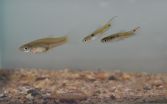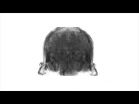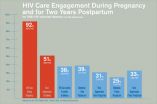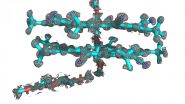(Press-News.org) August 24, 2015 - In the western foothills and mountain rangelands of the U.S., wild larkspurs (Delphinium spp.) are a major cause of cattle losses.
For the most part, grazing cattle can self-regulate consumption of larkspurs and avoid toxicity problems. However, when cattle eat too much, too quickly, or they eat low amounts continuously, toxicity can occur. Symptoms of toxicity include muscle weakness. Cattle also can become non-ambulatory and die.
In a recent study published in the Journal of Animal Science, researchers with the USDA-ARS Poisonous Plant Research Laboratory in Logan, Utah, determined the amount of tall larkspur that a 1,100-pound steer could consume without becoming poisoned. Until now, there has been little research that mimics the multiple exposures of larkspur to grazing cattle.
During the study, 12 steers received one dosing of tall larkspur equivalent to 8 mg "MSAL-type" alkaloids per kg of body weight (BW). Certain alkaloids found in larkspur are toxic to cattle. "MSAL-type" are the most common of the toxic alkaloids. All 12 steers experienced signs of toxicity, becoming non-ambulatory.
Following a three-month rest period, the cattle received a daily dose of 8, 4 or 2 mg MSAL alkaloids per kg BW for 4 days, or until they showed signs of muscle weakness.
None of the steers that received 2 mg/kg BW per day developed muscle weakness, even after 8 doses (4 days). The steers were able to successfully walk for 20 min each day. However, all of the steers dosed with 4 mg MSAL alkaloids/kg BW per day could not walk for 20 minutes at the 48-hour mark. These results suggest that the "no observable adverse effect level," or NOAEL, is 2 mg/kg BW per day.
After computer modeling, the researchers found that a 1,102 pound (500 kg) steer can consume a daily dose of 2.8 pounds (1.25 kg) of fresh tall larkspur without becoming severely poisoned.
The authors note that "the ratio of non-MSAL-type to MSAL-type alkaloids has an important impact on the toxicity potential of tall larkspur populations." Consequently the results from this study (e.g., a NOAEL of 2 mg/kg MSAL-type alkaloids per day) may only be valid for larkspur populations that contain 4 mg/g MSAL-type alkaloids and 16 mg/g total alkaloids.
Larkspur contains about 15-20% crude protein and is palatable to cattle. In order to reduce toxicity problems, producers should not allow cattle to graze after larkspur has begun to flower and/or very late in the summer when the pods begin to shatter.
INFORMATION:
To read the study in its entirety in the August 2015 issue of the Journal of Animal Science, visit http://takingstock.asas.org/?p=17237.
In the animal world, sexual reproduction can involve males attempting to entice or force females to mate with them, even if they are not initially interested.
This male behaviour is driven by conflicts of interest over reproduction and exerts selective pressures on both sexes.
A new study on guppies led by the universities of Glasgow and Exeter has given scientists insight into how this behaviour can lead to physiological changes, much like those in athletes who train to perform better.
Dr Shaun Killen, of the University of Glasgow, said: "Sexual coercion of females ...
Boulder, Colo., USA - In the last few months, it has once more become clear that large earthquakes can solicit catastrophic landsliding. In the wake of the Nepal earthquake, the landslide community has been warning of persistent and damaging mass wasting due to monsoon rainfall in the epicentral area. However, very little is actually known about the legacy of earthquakes on steep, unstable hillslopes.
Using a dense time series of satellite images and air photos, Odin Marc and colleague reconstructed the history of landsliding in four mountain areas hit by large, shallow ...
Washington, DC - August 25, 2015 - Scientists in the Center for Infection and Immunity at the Mailman School of Public Health have discovered a new virus in seals that is the closest known relative of the human hepatitis A virus. The finding provides new clues on the emergence of hepatitis A. The research appears in the July/August issue of mBio, the online open-access journal of the American Society for Microbiology.
"Until now, we didn't know that hepatitis A had any close relatives and we thought that only humans and other primates could be infected by such viruses," ...
TAMPA, Fla. - Women who have inherited mutations in the BRCA1 or BRCA2 genes are more likely to develop breast cancer or ovarian cancer, especially at a younger age. Approximately 5 percent of women with breast cancer in the United States have mutations in BRCA1 or BRCA2 based on estimates in non-Hispanic white women. Moffitt Cancer Center researchers recently conducted the largest U.S. based study of BRCA mutation frequency in young black women diagnosed with breast cancer at or below age 50 and discovered they have a much higher BRCA mutation frequency than that previously ...
The burning of incense might need to come with a health warning. This follows the first study evaluating the health risks associated with its indoor use. The effects of incense and cigarette smoke were also compared, and made for some surprising results. The research was led by Rong Zhou of the South China University of Technology and the China Tobacco Guangdong Industrial Company in China, and is published in Springer's journal Environmental Chemistry Letters.
Incense burning is a traditional and common practice in many families and in most temples in Asia. It is not ...
Depressed people who turn to their smart phones for relief may only be making things worse.
A team of researchers, that included the dean of Michigan State University's College of Communication Arts and Sciences, found that people who substitute electronic interaction for the real-life human kind find little if any satisfaction.
In a paper published in the journal Computers in Human Behavior, the researchers argue that relying on a mobile phone to ease one's woes just doesn't work.
Using a mobile phone for temporary relief from negative emotions could worsen psychological ...
MADISON -- Colorful and expressive, the eyes are central to the way people interact with each other, as well as take in their surroundings.
That makes amblyopia -- more commonly known as "lazy eye" -- all the more obvious, but the physical manifestation of the most common cause of vision problems among children the world over is actually a brain disorder.
"Most often in amblyopia patients, one eye is better at focusing," says Bas Rokers, a University of Wisconsin-Madison psychology professor. "The brain prefers the information from that eye, and pushes down the signal ...
Pregnancy could be a turning point for HIV-infected women, when they have the opportunity to manage their infection, prevent transmission to their new baby and enter a long-term pattern of maintenance of HIV care after giving birth--but most HIV-infected women aren't getting that chance. That is the major message from a pair of new studies in Philadelphia, one published early online this month in the journal Clinical Infectious Diseases, and the other published in July in PLOS ONE.
The studies, led by a team of researchers from Drexel University and the Philadelphia Department ...
A team from the University of Illinois at Urbana-Champaign and Indiana University combined two techniques to determine the structure of cyanostar, a new abiological molecule that captures unwanted negative ions in solutions.
When Semin Lee, a chemist and Beckman Institute postdoctoral fellow at Illinois, first created cyanostar at Indiana University, he knew the chemical properties, but couldn't determine the precise atomical structure. Lee synthesized cyanostar for its unique ability to bind with large, negatively charged ions, which could have applications such as ...
Many political leaders, scientists, educators and parents believe that failure is the best teacher.
Scientists have long understood that the brain has two ways of learning. One is avoidance learning, which is a punishing, negative experience that trains the brain to avoid repeating mistakes. The other is reward-based learning, a positive, reinforcing experience in which the brain feels rewarded for reaching the right answer.
A new MRI study by USC and a group of international researchers has found that having the opportunity to learn from failure can turn it into ...




